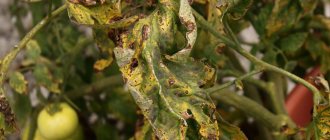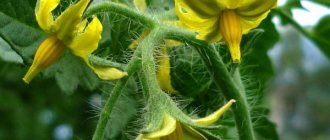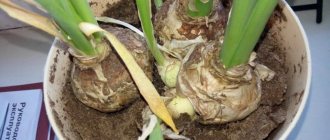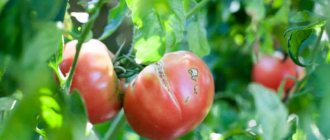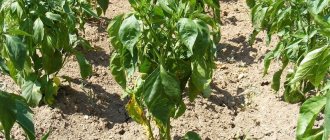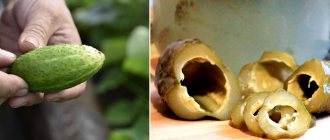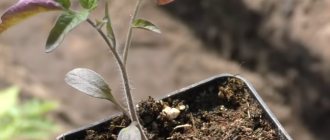Even the strongest, well-developed tomato bushes sometimes produce a weak harvest.
The problem may be due to unstable, changeable weather with sharp changes in day and night temperatures. Sometimes the loss or absence of ovaries is a signal of a lack of nutrients in the soil or improper formation of the bush. The problem can be solved; moreover, there are ways to increase the yield of tomatoes.
Conditions necessary for setting tomatoes
It is sometimes difficult for an inexperienced summer resident to “please” tomatoes. It is especially important to take into account all the features of the plant during the period of its flowering and fruit set:
- Fruit setting occurs best at a temperature of +21 - +23°C;
- comfortable air humidity in the greenhouse is 60%;
Early flowering of tomatoes in a greenhouse
- tomatoes require watering only at the root (so that water does not get on the stems, leaves and flowers);
- watering plants at the flowering stage should be infrequent (a couple of times a week), but plentiful;
- Frequent loosening of the soil is required;
- Mulching the soil is encouraged.
Important nuances
When feeding tomatoes, it is important not to forget about other care rules.
This is especially true for watering, since if there is a lack of moisture, not a single fertilizer can save the plant..
Here you must adhere to the following rules:
- During the formation of buds, it is important to pour at least 5 liters of water under each bush once every 7 days.
- During the fruiting period, it is necessary to water more often - at least 2 times every 7 days.
It is important to remember that proper care and timely application of fertilizing will not go in vain and will be rewarded with a bountiful and tasty harvest.
There are many different types of fertilizers for the flowering period of tomatoes. The choice of a specific type depends on the preferences of the gardener. In this process, special attention should be paid to the correct preparation of the solution and application of funds.
Violation of the temperature regime in the greenhouse
Tomatoes are very picky about temperature conditions. Therefore, even in a greenhouse you need to very carefully monitor changes in air temperature. After all, it is precisely its fluctuations that often become the main reason why fruit ovaries do not form on the bushes after flowering.
Diagram: how a tomato flower works. Important! A clear sign of a lack of heat will be that the plant’s stems and leaves develop too intensively, but the flowers are weak.
- If the plant is too hot during the flowering period, the flowers will not be pollinated. The fact is that at temperatures above +30°C, the plant’s pollen loses its fertilizing properties. Even overheating for 1 day will be enough for tomatoes to lose their ability to set fruit.
- Air temperatures below +15°C will be too cold for flowering tomatoes. In this case, the plant will stop its growth, the development and fertilization of flowers will not occur.
- At night, it is important to ensure optimal temperature and access to fresh air in the greenhouse. If the plant overheats in the dark, it will spend too much energy and nutrients to maintain vital functions; on a weakened plant, fruits will not set after flowering. If it is quite cold at night, then the heating in the greenhouse should be turned on: after a hot day, condensation may form on the bushes, and the humidity will rise sharply.
Advice! To water tomatoes in a greenhouse, do not use too cold water; this can lead to freezing of the plant roots and problems with fruit set.
Universal fruit formation stimulator - “Ovary”, “Gibbersib bio”: composition, pros and cons
Universal growth stimulants are nothing more than phytohormones, which, when applied to green plants, begin to stimulate intensive fruit growth. gibberellic acids and sodium salts are used as activators of such processes .
Advantages of a universal fruit formation stimulator:
- Does not harm people, animals or insects
- Begins to act on the plant literally from the first minutes of treatment
- Helps increase the resistance of tomatoes to various diseases
- Stimulates the formation of new cells
- Prevents the formed flowers from dying and falling off
- Increases the formation of tomato fruits by 10-25%
- Helps the resulting fruits to ripen faster
Disadvantages of a universal fruiting stimulator:
- Some varieties of tomatoes react poorly to active substances
- Due to the high activity of stimulating substances, the drug requires the most accurate preparation of the solution
- Only active in maximum light
- The maximum effect can only be achieved with spot treatment of each bush.
Controlling humidity when setting tomatoes
The optimal air and soil humidity in a greenhouse for growing tomatoes is the second, but not least important, indicator that affects fruit set. Not only the yield, but the health of the plants depends on the control of humidity in the greenhouse: if the standards are not followed, fungal diseases of the crop may develop or parasites may appear.
Tomato flowers that did not produce fruit
- A significant increase in air humidity in the greenhouse will inevitably lead to the absence of ovaries on tomatoes - the flowers will simply begin to crumble. The fact is that, saturated with excess moisture, the pollen sticks together and loses the ability to spill out of the anthers, which means pollination cannot occur. Excess moisture can form in the greenhouse after watering: if the windows are closed, moisture begins to settle on the leaves and flowers of the plant - this phenomenon is called the greenhouse effect.
- On the contrary, if the air in the greenhouse is too dry, then the pollen already on the pistil will not be able to germinate. However, once the fruits have set, the plant will normally be able to tolerate short dry periods.
- To increase air humidity and slightly reduce the temperature, you can pour cold water on the paths in the greenhouse. However, such humidification can be carried out only in the first half of the day, so that the evaporation of moisture at night does not create a greenhouse effect in the greenhouse.
Important! If you notice that the plant is drooping and its leaves are starting to curl, this is an alarming signal and a sure sign of a lack of moisture.
Late stepsoning
Many varieties and hybrids need pinching. The procedure boils down to removing side shoots in the leaf axils. This should be done at the stage of the formation of the layer, when it has grown no more than 5 cm. Pinch it by hand, leaving a small stump of 1 cm. The cut site can be treated with a weak solution of potassium permanganate (1-1.5%).
If you remove already quite large stepsons, this can lead to problems with fruit set.
Stepchildren must be removed before they reach 5 cm in length
“Nutrition” of tomatoes in a greenhouse
Even during the period of planting seedlings in a greenhouse, many gardeners make a serious mistake - they overfeed the young plant with fertilizers. Often mullein, bird droppings, urea or saltpeter are used - fertilizers containing large amounts of nitrogen. After all, it is difficult to resist feeding when after it the seedlings become stronger and grow literally before our eyes. However, such growth of leaf mass under the influence of nitrogen leads to the fact that fruits on the bush do not set, and the roots of the bush become weak.
Strong flowering tomato cluster
Therefore, it is very important to know that fertilizing with nitrogen-containing fertilizers can be carried out only after fruits have set on the bushes. In this case, the beneficial substances will not go into leaf growth, but into fruit development. Another problem is the decrease in the amount of potassium in the soil during fruit set. As for urea, it is used for depleted soils, so there is no need to use urea in a greenhouse.
Useful tips
Experienced gardeners are already accustomed to getting excellent tomato yields. But beginners may have difficulties with this. Don’t worry if you are not a very experienced gardener yet, our tips will definitely help you:
- There is never too much light for tomatoes, so when planting seedlings in a greenhouse in the spring, it is better to use additional lighting at first. The better the illumination at each stage of development of tomato bushes, the greater the harvest will be.
- In addition to shaking the brushes, spraying with fruiting stimulants (“Bud”, “Ovary”) can help pollination and the formation of the ovary. These drugs are specially designed to increase the number of ovaries and its further development.
- Periodically hill up the bushes with damp soil. This should be done during periods when the plant is ready to grow additional roots. In this case, looking closely at the bottom of the central stem, you will notice small protruding tubercles on it, which are the rudiments of roots. When the plant trunk acquires a bluish tint from below, hill up the tomatoes again. Only plants with a strong root system will be able to bear fruit abundantly.
- After growing tomatoes in a greenhouse, do not throw away the tops, but chop them and embed them in the ground. It has long been noted that such organic fertilizing has a positive effect on the fruiting of tomatoes in the next season. Some people put a piece of raw fish in the hole when planting and claim that such feeding significantly improves the growth and productivity of tomatoes.
- Every 7-10 days, plant tomatoes in the greenhouse so that the bushes do not waste energy feeding excess greenery. In this case, the number of fruits set will increase. Remove the stepsons in the morning, leaving stumps no more than 0.5-1 cm long. Also regularly tear off the old lower leaves.
- Foliar feeding contributes to obtaining an early abundant harvest. Alternate them with applying fertilizers at the root. Spraying solutions are made based on whey, iodine, calcium and potassium nitrate, and urea.
What to do if the plant is overfed with fertilizers
If you notice that all the strength of the plant goes into the leaves, and the flowers are weak and do not pollinate, you need to:
- temporarily stop watering tomato bushes;
- ventilate the greenhouse well so that the air becomes drier;
- carry out foliar and root feeding of tomatoes with phosphorus fertilizer;
- remove some of the leaves, especially those that cover the flowers from the sun and air access.
A plant overfed with fertilizers has large, succulent leaves and weak flowers.
Lack of light
Tomatoes are light-loving crops, so you should choose only a well-lit area for planting. In this case, a distance of at least 30-40 cm should be left between the bushes, and in some cases - 50-60 cm (recommendations for the planting scheme are given in the description of each variety). There is no point in saving space, since placing bushes too densely will interfere with their development, which will inevitably affect the yield.
Lack of light also leads to shedding of ovaries
Pollination of tomatoes in a greenhouse
If tomatoes are grown in the ground, then their pollination occurs naturally: wind and insects carry pollen. However, if you are growing a crop in a greenhouse, you cannot ignore the issue of pollination.
Natural pollination of tomatoes in a greenhouse
- In the warm season, greenhouses must be opened for ventilation and access for beneficial insects. And if the air temperature outside is stable and stays within +20 - +26°C, then you can leave the greenhouse open even at night.
- In the cold season, when tomatoes are grown in a heated greenhouse, pollination should be carried out artificially, and care should be taken about the ventilation system.
Advice! To attract bees to naturally pollinate tomatoes, plant honey plants in the greenhouse or simply bring pots of flowers.
How to pollinate tomatoes in a greenhouse artificially
If you notice that natural pollination does not occur and there is no ovary on the tomatoes, then take measures to pollinate manually. There are several effective ways to do this:
- Lightly shake the tomato plant or tap its main stem. Often such a slight movement is enough to wake up the pollen.
- You can create an artificial gust of wind using a fan. To do this, turn on the device and walk with it along the rows of tomatoes.
- The oldest method of hand pollination involves the use of an ordinary brush. This way you can transfer pollen to the pistil of the flower.
- Some gardeners use an electric toothbrush for hand pollination. Turn on the device and bring it to the flower (do this carefully so as not to damage the plant). Vibrating the brush will help transfer pollen.
Important! You can visually determine whether a flower is pollinated. If pollination has occurred, the flower petals will open and tilt back.
It is very important to water the tomatoes after pollination, and also lightly spray them with a spray bottle - this will create the air humidity necessary for pollen germination.
Precautionary measures
The pesticide belongs to the third hazard class, which means a low level of toxicity. The instructions for the drug indicate that when working with it you must adhere to the following safety rules:
- do not contact people with an allergic reaction to gibberellins with the working solution and powder;
- before work, you need to cover your eyes, hair, and skin with clothes and accessories;
- It is strongly recommended to wear a gauze bandage on the mouth and nose;
- the drug must not be diluted in containers intended for cooking;
- if the powder or working solution gets on the skin, respiratory system or eyes, you need to wash it off with plenty of clean water;
- If the Ovary is swallowed, induce vomiting and take activated charcoal.
Forming a bush for setting tomato fruits
Even if everything is in order with the temperature and humidity in the greenhouse, fruits may not set on the bushes. And the problem may lie in the plant itself, or more precisely, in the mistakes of inexperienced summer residents.
Removing tomato flowers damaged by fungal disease
- Many hybrid varieties of tomatoes cannot be grown from their own seeds - such plants will not produce ovaries.
- Spraying with pesticides during the flowering period will certainly have a negative impact on fruit set (pollen will lose its productivity).
- Care must be taken to ensure that no harmful insects or fungal diseases appear on the bushes. A weakened plant will not bear fruit.
- Tomatoes must have enough sun, so you need to set up a greenhouse on the sunny side of the site, and also plant the bushes so that they are not crowded and do not block each other’s light.
- Leave one stem on each bush and pruning - this will make the bush stronger and prepare it for fruit development.
Causes of flower falling
It often happens that well-developing seedlings suddenly dry out. There are many reasons for this:
- Overmoistening of the soil. It is necessary to strictly observe the measure of watering the plant, because this is the main reason for the fall of the ovary of tomatoes in a greenhouse.
- Decrease in air temperature.
- Poor lighting.
- Planting too thick. If the bushes are placed too close, this will not be beneficial, since they will shade each other. The result is either late ripening of fruits or the formation of barren flowers. To fix the problem, you will need to destroy every ovary.
- Incorrect placement of beds. In areas with good lighting, low-growing tomatoes should be placed, and taller ones should be planted after them.
- Untimely feeding of the plant. This plays a big role, because you can’t feed the crop too often. Otherwise, the tomatoes will shade each other. In addition, this is why tomato ovaries in the greenhouse fall off.
How to treat tomatoes for fruit set in a greenhouse
In order to increase the yield of tomatoes, experienced gardeners recommend spraying them with a solution of boric acid during flowering. To do this, dissolve boric acid powder (10 g) in one bucket of warm water. A lack of phosphorus can be detrimental to bushes. To feed tomatoes, you will need superphosphate extract or phosphate fertilizer.
Mineral fertilizers for tomatoes
- To obtain superphosphate extract, dilute it (3 tablespoons) in a liter of warm water. And then let the composition brew for two days. Don't forget to stir the solution. Then remove the sediment, and the resulting tincture can be fed to the plants: 1 liter per root.
- Phosphate fertilizer can be purchased at a specialty store. It contains 50% phosphorus and 40% potassium. The powder dissolves quickly in water and is immediately ready for use.
Advice! Root feeding is applied after the bushes are watered with ordinary water.
Folk remedies for increasing the number of ovaries
Not all gardeners use all kinds of stimulants or chemicals to support tomatoes. Folk remedies are often used to increase the number of ovaries.
Therefore, we will consider the most effective and time-tested means that will not allow the color to fade and will help the ovaries to form on tomatoes:
- Dry ash is taken and distributed over the soil. But the distribution must be done carefully; the plants should not be pollinated with ash. It is advisable to scatter the ash from the stem at a distance of 10 centimeters. Gradually, with irrigation, the ash will penetrate the soil and nourish it with enough potassium and other useful substances to set small tomatoes.
- Iodine also copes well with this task. Just one drop of iodine per liter of water is enough to shed tomato bushes.
- A combined feeding method is also used. The recipe includes a bottle of iodine (standard), boric acid (powder 10 grams), dry wood ash (1 liter is enough). All components are diluted in 10 liters of settled water. The mixture is kept for 24 hours and then one liter of solution is added to each bush. This feeding is done once at the stage of ovary formation.
- Ordinary culinary yeast is also used as an effective fertilizer. For one bucket of water (10 l), it is enough to take 100 grams of yeast and two tablespoons of sugar. The components are diluted and given time for natural fermentation. It will take 48 hours to 6 days to activate the yeast. The composition can then be used for irrigation, but the fermented yeast is diluted before use. Optimal concentration: a glass of the resulting solution per 10 liters of settled water.
For the above recipes, the main thing is to follow the rule: do not apply the solution to dry soil, otherwise it will negatively affect the root system.
It is better to water the tomato bushes generously with regular water, saturating the soil to a great depth. Wait one or two days depending on the weather. And only then add one of the prepared fertilizers.
This fertilization is done once. But, if it rains in the coming days or the composition does not have a clear effect, then after 5-7 days the procedure is repeated. When applying fertilizing a second time, reduce the amount of applied solution by 2 times or reduce its concentration by half.


